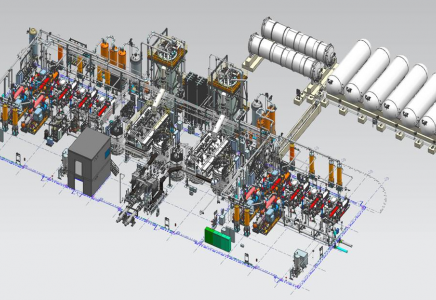SLAC National Accelerator Lab's Linac Coherent Light Source (LCLS) produces the world’s brightest X-ray laser pulses for research. When it came online in 2009, the machine enabled new areas of science, opening frontiers in imaging single nanoscale particles and in understanding chemistry on the natural timescales of reactions. In 2013, SLAC engaged Jefferson Lab in its bid to upgrade LCLS with the addition of superconducting radiofrequency (SRF) technology. Jefferson Lab is a world leader in several of the technologies fundamental to the upgrade, dubbed LCLS-II, including SRF technology and controls, and the liquid helium cryogenics plant technology that makes SRF possible.
Jefferson Lab designed and worked with SLAC to procure, install, and commission the liquid helium cryogenics plants for the project and built half of the SRF cryomodules that were installed in the first 700 meters of the LCLS complex. Late last year, Jefferson Lab delivered its final new cryomodule for the LCLS. And now, for the first time, those cryomodules have gone cold.
According to Jonathan Creel, Cryogenics Department lead, the effort culminated in the complete commissioning of one of the two brand new cryogenics plants.
"Over the last couple of years, we have been helping them commission each part of their new plant and bring it online," Creel explained. "Since January, we have assisted them to cool down and commission the cold transferline systems and cooled down and filled all of their cryomodules with 4.5 K liquid helium."
He says the success of all this hard work was achieved over the last few weeks as Creel, Robert Norton and Ritendra Bhattacharya served as the JLab commissioning team and assisted the SLAC cryogenics team to develop and execute the commissioning plan for their plant's 2 K cold box. The team successfully developed and demonstrated a pumpdown path and helped the SLAC cryogenics group reach stable 2 K cryogenic operation in their cryomodules.
Creel attributes the successful ‘chill out’ to the many Jefferson Lab staff members across departments who contributed to the project.
"The design and construction management was a huge effort that spanned many groups here at Jefferson Lab, including cryogenics, mechanical engineering, procurement, and the project management office," said Creel.
Now that LCLS's SRF linear accelerator is cold, SLAC plans to begin commissioning its new cryomodules and systems toward preparing for operations.
You can read more about this milestone here: https://www.jlab.org/news/releases/slacs-superconducting-x-ray-laser-reaches-operating-temperature-colder-outer-space
By Kandice Carter


